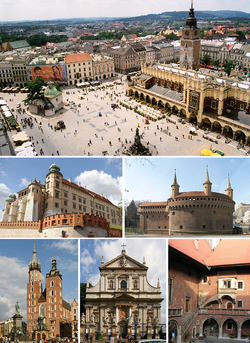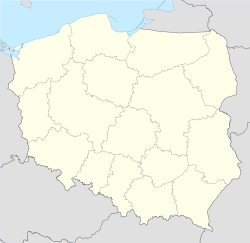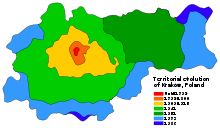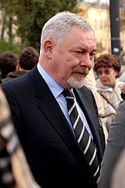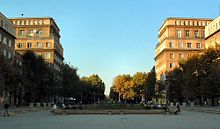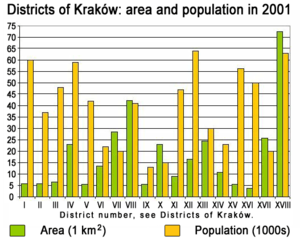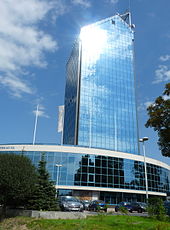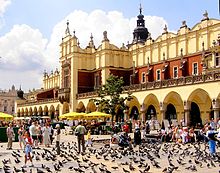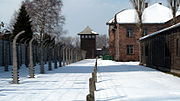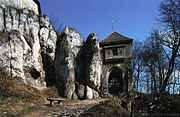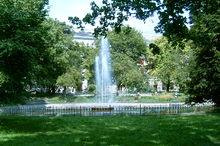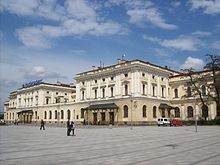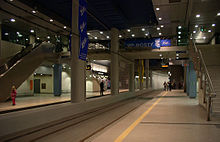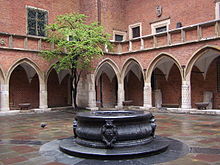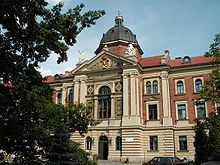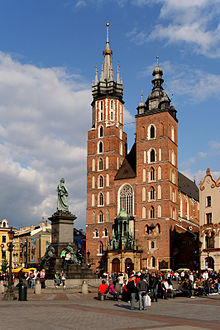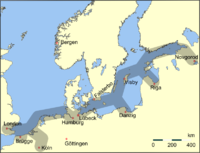- Kraków
-
For other uses, see Krakow (disambiguation) and Cracow (disambiguation).
Kraków Main Market Square, Wawel Castle, Barbican, St. Mary's Basilica, St. Peter and Paul Church, Collegium Maius 
Flag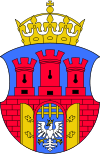
Coat of armsCoordinates: 50°3′41″N 19°56′18″E / 50.06139°N 19.93833°E Country  Poland
PolandVoivodeship Lesser Poland County Kraków County City rights 5 June 1257 Government – Mayor Jacek Majchrowski Area – City 327 km2 (126.3 sq mi) Elevation 219 m (719 ft) Population (2010) – City 756,267 – Density 2,312.7/km2 (5,990/sq mi) – Metro 1,449,783 (as of 2,006 UNIQ4fd7,529e4c5b6,783-ref-00,000,908-QINU) Demonym Cracovian Time zone CET (UTC+1) – Summer (DST) CEST (UTC+2) Postal code 30-024 to 31-962 Area code(s) +48 12 Website www.krakow.pl Kraków (Polish pronunciation: [ˈkrakuf] (
 listen)) also Krakow, or Cracow (English /ˈkrækaʊ/), is the second largest and one of the oldest cities in Poland. Situated on the Vistula River (Polish: Wisła) in the Lesser Poland region, the city dates back to the 7th century.[2] Kraków has traditionally been one of the leading centres of Polish academic, cultural, and artistic life and is one of Poland's most important economic hubs. It was the capital of Poland from 1038 to 1596; the capital of the Grand Duchy of Kraków from 1846 to 1918; and the capital of Kraków Voivodeship from the 14th century to 1999. It is now the capital of the Lesser Poland Voivodeship.
listen)) also Krakow, or Cracow (English /ˈkrækaʊ/), is the second largest and one of the oldest cities in Poland. Situated on the Vistula River (Polish: Wisła) in the Lesser Poland region, the city dates back to the 7th century.[2] Kraków has traditionally been one of the leading centres of Polish academic, cultural, and artistic life and is one of Poland's most important economic hubs. It was the capital of Poland from 1038 to 1596; the capital of the Grand Duchy of Kraków from 1846 to 1918; and the capital of Kraków Voivodeship from the 14th century to 1999. It is now the capital of the Lesser Poland Voivodeship.The city has grown from a Stone Age settlement to Poland's second most important city. It began as a hamlet on Wawel Hill and was already being reported as a busy trading centre of Slavonic Europe in 965.[2] With the establishment of new universities and cultural venues at the emergence of the Second Polish Republic and throughout the 20th century, Kraków reaffirmed its role as a major national academic and artistic centre. The city has a population of approximately 760,000 whereas about 8 million people live within a 100 km radius of its main square.[3]
After the invasion of Poland by Nazi Germany at the start of World War II, Kraków was turned into the capital of Germany's General Government. The Jewish population of the city was moved into a walled zone known as the Kraków Ghetto, from which they were sent to extermination camps such as Auschwitz and the concentration camp at Płaszów.
In 1978, Karol Wojtyła, archbishop of Kraków, was elevated to the papacy as Pope John Paul II – the first Slavic pope ever, and the first non-Italian pope in 455 years.[4] Also that year, UNESCO approved the first ever sites for its new World Heritage List, including the entire Old Town in inscribing Cracow's Historic Centre.[5][6]
Contents
Etymology
The name of Kraków is traditionally derived from Krakus (Krak, Grakch), the legendary founder of Kraków and a ruler of the tribe of Lechitians (Poles). In Polish, Kraków is an archaic possessive form of Krak and essentially means "Krak's (town)". Krakus's name may derive from "krakula", a Proto-Slavic word[7] meaning a judge's staff, or a Proto-Slavic word "krak" meaning an oak, once a sacred tree most often associated with the concept of genealogy. The first mention of Prince Krakus (then written as Grakch) dates back to 1190, although the town existed as early as the 7th century, inhabited by the tribe of Wiślanie.[2]
The city's full official name, used on ceremonial occasions, is Królewskie Stołeczne Miasto Kraków,[8] meaning "Royal Capital City of Kraków". In English, a person born, or living, in Kraków is a Cracovian (Polish: Krakowianin).
History
Main article: History of KrakówEarly history
Kraków's prehistory begins with evidence of a Stone Age settlement on the present site of the Wawel Hill.[9] A legend attributes Kraków's founding to the mythical ruler Krakus, who built it above a cave occupied by a dragon, Smok Wawelski.[10] The first written record of the city's name dates back to 966, when Kraków was described as a notable commercial centre owned by a Bohemian duke.[2] Mieszko took Kraków from Bohemians and incorporated it into the holdings of the Piast dynasty towards the end of his reign.[11]
Ethnic structure of Kraków, Kazimierz and Kleparz population in the 14th century[12] Ethnic Group City proper Kazimierz
suburbKleparz
suburbCommunity Poles Circa 5,000 Circa 1,500 Circa 1,000 7,500 Germans Circa 3,500 – – 3,500 Jews Circa 800 – – 800 Hungarians and/or Italians Circa 200 – – 200 Others Circa 500 – – 500 Subtotal (townsfolk) 10,000 1,500 1,000 12,500 Court, soldiery & clergy Circa 2,500 Grand total (population) Circa 15,000 Source: T. Ladenberger, Zaludnienie Polski na początku panowania Kazimierza Wielkiego, Lwów, 1930, p. 63 In 1038, Kraków became the seat of the Polish government.[2] By the end of the 10th century, the city was a leading centre of trade.[13] Brick buildings were constructed, including the Royal Wawel Castle with St. Felix and Adaukt Rotunda, Romanesque churches such as St. Adalbert's, a cathedral, and a basilica.[14] The city was almost entirely destroyed during the Mongol invasion of 1241. It was rebuilt in a form practically unaltered, and incorporated in 1257 by the king, with city rights based on the Magdeburg law allowing for tax benefits and new trade privileges for its citizens.[15] In 1259, the city was again ravaged by the Mongols. A third attack followed in 1287, repelled thanks in part to the new built fortifications.[16]
The city rose to prominence in 1364, when Casimir III of Poland founded the University of Kraków,[17] the second oldest university in central Europe after the Charles University in Prague. The city continued to grow under the joint Lithuanian-Polish Jagiellon dynasty. As the capital of the Kingdom of Poland and a member of the Hanseatic League, the city attracted many craftsmen, businesses, and guilds as science and the arts began to flourish.[18]
Golden age
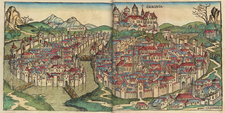 Woodcut of Kraków, Nuremberg Chronicle (1493)
Woodcut of Kraków, Nuremberg Chronicle (1493)
The 15th and 16th centuries were known as Poland's Złoty Wiek or Golden Age.[19] Many works of Polish Renaissance art and architecture were created then,[20][21] including ancient synagogues in Kraków's Jewish quarter of Kazimierz, such as the Old Synagogue.[22] During the reign of Casimir IV, various artists came to work and live in Kraków, and Johann Haller established a printing press in the city[23] after Kasper Straube had printed the Calendarium Cracoviense, the first work printed in Poland, in 1473.[24][25]
In 1520, the most famous church bell in Poland, named Zygmunt after Sigismund I of Poland, was cast by Hans Behem.[26] At that time, Hans Dürer, a younger brother of Albrecht Dürer, was Sigismund's court painter.[27] Hans von Kulmbach made altarpieces for several churches.[28] In 1572, King Sigismund II, the last of the Jagiellons, died childless. The Polish throne passed to Henry III of France and then to other foreign-based rulers in rapid succession, causing a decline in the city's importance that was worsened by pillaging during the Swedish invasion and by an outbreak of bubonic plague that left 20,000 of the city's residents dead. In 1596, Sigismund III of the Swedish House of Vasa moved the capital of the Polish–Lithuanian Commonwealth from Kraków to Warsaw.[29]
18th to early 20th century
Already weakened during the 18th century, by the mid-1790s the Polish–Lithuanian Commonwealth had been twice partitioned by its neighbors: Russia, the Habsburg empire, and Prussia.[30] In 1794, Tadeusz Kościuszko initiated an unsuccessful insurrection in the town's Main Square which, in spite of his victorious Battle of Racławice against a numerically superior Russian army, resulted in the third and final partition of Poland.[31] Following the Uprising, Kraków became part of the Austrian partition in a province of the Kingdom of Galicia and Lodomeria. In 1809, Napoleon Bonaparte captured former Polish territories from Austria and made the town part of the Duchy of Warsaw.[32] Following Napoleon's defeat in Russia, the Congress of Vienna in 1815 mostly restored earlier structures, although it also created the partially independent Free City of Kraków.[33] As in 1794, an insurrection in 1846 failed;[32] resulting in the city being annexed by Austria under the name the Grand Duchy of Krakow (Polish: Wielkie Księstwo Krakowskie).[34]
 St. Mary's Square with St. Mary's Basilica (left)
St. Mary's Square with St. Mary's Basilica (left)
In 1866, Austria granted a degree of autonomy to Galicia after the Austro-Prussian War,[35] and Kraków became a Polish national symbol and a centre of culture and art, known frequently as the "Polish Athens" (Polskie Ateny) or "Polish Mecca".[36] Many leading Polish artists of the period resided in Kraków,[37] among them the seminal painter Jan Matejko,[38] laid to rest at Rakowicki Cemetery, and the founder of modern Polish drama, Stanisław Wyspiański.[39] Fin de siècle Kraków evolved into a modern metropolis;[40] running water and electric streetcars were introduced in 1901,[41] and between 1910 and 1915, Kraków and surrounding suburban communities were gradually combined into a single administrative unit called Greater Kraków (Wielki Kraków).[42]
At the outbreak of World War I on 3 August 1914, Józef Piłsudski formed a small cadre military unit, the First Cadre Company—the predecessor of the Polish Legions—which set out from Kraków to fight for the liberation of Poland.[43] The city was briefly besieged by Russian troops in November 1914, but they were pushed back afterwards.[44] The Austrian rule in Kraków ended in 1918 when the Polish Liquidation Committee assumed power.[45][46]
1918 to the present
With the emergence of the Second Polish Republic, Kraków restored its role as a major academic and cultural centre with the establishment of new universities such as the AGH University of Science and Technology and the Jan Matejko Academy of Fine Arts, including a number of new and essential vocational schools. It became an important cultural centre for the Polish Jews with a Zionist youth movement relatively strong among the city's Jewish population.[47] Kraków was also an influential centre of Jewish spiritual life, with all its manifestations of religious observance from Orthodox, to Chasidic and Reform flourishing side by side.
 Tempel Synagogue, with Neo-Moorish façade
Tempel Synagogue, with Neo-Moorish façade
Following the invasion of Poland in September 1939, the Nazi German forces turned the city into the capital of the General Government, a colonial authority headed by Hans Frank and seated in Wawel Castle. In an operation called "Sonderaktion Krakau", more than 180 university professors and academics were arrested and sent to Sachsenhausen and Dachau concentration camps, though the survivors were later released on the request of prominent Italians.[48][49] The Jewish population was first confined to a ghetto and later murdered or sent to concentration camps, including Płaszów and Auschwitz in Oświęcim.[50] Roman Polanski, the film director, is a survivor of the Ghetto, while Oskar Schindler, the German businessman portrayed in the Steven Spielberg film Schindler's List, selected employees from the Ghetto to work in his enamelware plant (Deutsche Emailwaren Fabrik, or Emalia for short), thus saving them from the camps.[51][52]
Kraków remained relatively undamaged at the end of World War II.[53] After the war, under the Stalinist regime, the intellectual and academic community of Kraków was put under total political control. The universities were soon deprived of their printing rights as well as their autonomy.[54] The communist government of the People's Republic of Poland ordered construction of the country's largest steel mill in the newly created suburb of Nowa Huta.[55] The creation of the giant Lenin Steelworks (now Sendzimir Steelworks owned by Mittal) sealed Kraków's transformation from a university city to an industrial centre.[56] The new working class, drawn by the industrialization of the city, contributed to its rapid population growth.
In an effort that spanned two decades, Karol Wojtyła, cardinal archbishop of Kraków, successfully lobbied for permission to build the first churches in the new industrial suburbs.[56][57] In 1978, Wojtyła was elevated to the papacy as John Paul II, the first non-Italian pope in 455 years. In the same year, UNESCO placed Kraków Old Town on the first ever list of World Heritage Sites.
Geography
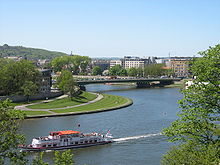 Vistula River and Dębnicki Bridge
Vistula River and Dębnicki Bridge
Kraków lies in the southern part of Poland, on the Vistula River, in a valley at the foot of the Carpathian Mountains, 219 m (719 ft) above sea level; half way between the Jurassic Rock Upland (Polish: Jura Krakowsko-Częstochowska) to the north, and the Tatra Mountains 100 km (62 mi) to the south, constituting the natural border with Slovakia and the Czech Republic; 230 km west from the border with Ukraine. There are five nature reserves in Kraków, with a combined area of ca. 48.6 hectares (120 acres). Due to their ecological value, these areas are legally protected. The western part of the city, along its northern and north-western side, borders an area of international significance known as the Jurassic Bielany-Tyniec refuge. The main motives for the protection of this area include plant and animal wildlife and the area's geomorphological features and landscape.[58] Another part of the city is located within the ecological 'corridor' of the Vistula River valley. This corridor is also assessed as being of international significance as part of the Pan-European ecological network.[59] The city center is situated on the left (northern) bank of the river.
Climate
Kraków has an Oceanic climate (Cfb) according to the Köppen climate classification system, one of the easternmost localities in Europe to do so (East of Tarnów, and north of Kielce the January mean dips below −3 °C (27 °F) and thus becomes continental (Dfb) in nature). The city features a temperate climate. Average temperatures in summer range from 18 °C (64 °F) to 19.6 °C (67 °F) and in winter from −2.1 °C (28 °F) to 0 °C (32 °F). The average annual temperature is 8.9 °C (48 °F). In summer temperatures often exceed 25 °C (77 °F), and sometimes even 30 °C (86 °F), while winter drops to −5 °C (23 °F) at night and about 0 °C (32 °F) at day; during very cold nights the temperature drops to −15 °C (5 °F). In view of the fact that Kraków lies near the Tatra Mountains, there is often blowing halny – a foehn wind, when the temperature rises rapidly, and even in winter reaches to 20 °C (68 °F).
Climate data for Kraków Month Jan Feb Mar Apr May Jun Jul Aug Sep Oct Nov Dec Year Record high °C (°F) 15.7
(60.3)21.0
(69.8)25.2
(77.4)29.6
(85.3)33.3
(91.9)35.5
(95.9)36.1
(97.0)36.7
(98.1)33.1
(91.6)27.7
(81.9)21.2
(70.2)18.9
(66.0)36.7
(98.1)Average high °C (°F) 1.1
(34.0)1.5
(34.7)7.9
(46.2)13.7
(56.7)19.8
(67.6)22.1
(71.8)24.2
(75.6)23.9
(75.0)19.2
(66.6)13.6
(56.5)5.0
(41.0)2.9
(37.2)12.9 Daily mean °C (°F) −2.1
(28.2)−1.8
(28.8)3.8
(38.8)9.6
(49.3)14.1
(57.4)18.0
(64.4)19.6
(67.3)19.3
(66.7)14.7
(58.5)9.2
(48.6)2.6
(36.7)0.0
(32.0)8.9 Average low °C (°F) −5.3
(22.5)−5.1
(22.8)−0.5
(31.1)5.5
(41.9)9.0
(48.2)13.8
(56.8)15.0
(59.0)14.7
(58.5)10.2
(50.4)4.8
(40.6)0.2
(32.4)−2.9
(26.8)5.0 Record low °C (°F) −29.9
(−21.8)−29.4
(−20.9)−22.9
(−9.2)−9.4
(15.1)−2.7
(27.1)0.6
(33.1)4.3
(39.7)2.0
(35.6)−4.1
(24.6)−7.9
(17.8)−17.7
(0.1)−25.5
(−13.9)−29.9
(−21.8)Precipitation mm (inches) 34
(1.34)34
(1.34)35
(1.38)42
(1.65)56
(2.2)84
(3.31)90
(3.54)82
(3.23)55
(2.17)44
(1.73)41
(1.61)34
(1.34)631
(24.84)% humidity 82 82 77 68 63 69 71 74 75 79 83 86 76 Avg. precipitation days 15 12 13 9 11 12 13 13 11 12 14 12 147 Sunshine hours 43 54 102 144 189 204 208 183 153 105 51 33 1,469 Source: Institute of Meteorology and Water Management[60] Governance
President of Kraków, Prof. Jacek Majchrowski For more details on this topic, see Local government in Kraków.
For more details on this topic, see Local government in Kraków.The Kraków City Council has 43 elected members,[61] one of whom is the mayor, or President of Kraków, elected every four years. The election of the City Council and of the local head of government,[62] which takes place at the same time, is based on legislation introduced on 20 June 2002. The current President of Kraków, re-elected for his third term in 2010, is Professor Jacek Majchrowski.[63] Several members of the Polish national Parliament (Sejm) are elected from the Kraków constituency.[64] The city's official symbols include a coat of arms, a flag, a seal, and a banner.[8]
The responsibilities of Kraków’s president include drafting and implementing resolutions, enacting city bylaws, managing the city budget, employing city administrators, and preparing against floods and natural disasters.[62] The president fulfills his duties with the help of the City Council, city managers and city inspectors. In the 1990s, the city government was reorganized to better differentiate between its political agenda and administrative functions. As a result, the Office of Public Information was created to handle inquiries and foster communication between city departments and citizens at large.[65]
In the year 2000, the city government introduced a new long-term program called "Safer City" in cooperation with the Police, Traffic, Social Services, Fire, Public Safety, and the Youth Departments. Subsequently, the number of criminal offences went down by 3 percent between 2000 and 2001, and the rate of detection increased by 1.4 percent to a total of 30.2 percent in the same period.[66] The city is receiving help in carrying out the program from all educational institutions and the local media, including TV, radio and the press.
 The 18 districts of Kraków, with Vistula River running west to east
The 18 districts of Kraków, with Vistula River running west to east
Districts
Main article: Districts of KrakówKraków is divided into 18 administrative districts (dzielnica) or boroughs, each with a degree of autonomy within its own municipal government.[67] Prior to March 1991, the city had been divided into four quarters which still give a sense of identity to Kraków - the towns of Podgórze, Nowa Huta, and Krowodrza which were absorbed by Kraków as it expanded, and the ancient town center of Kraków itself.[67]
The oldest neighborhoods of Kraków were incorporated into the city before the late 18th century. They include the Old Town (Stare Miasto), once contained within the city defensive walls and now encircled by the Planty park; the Wawel District, which is the site of the Royal Castle and the cathedral; Stradom and Kazimierz, the latter originally divided into Christian and Jewish quarters;[68] as well as the ancient town of Kleparz.
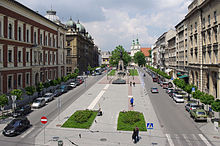 Matejko Square at Kleparz is one of the city's more important public spaces
Matejko Square at Kleparz is one of the city's more important public spaces
Major districts added in the 19th and 20th centuries include Podgórze, which until 1915 was a separate town on the southern bank of the Vistula, and Nowa Huta, east of the city centre, built after World War II.
The current divisions were introduced by the Kraków City Hall on 19 April 1995. Districts were assigned Roman numerals as well as the current name:[69] Stare Miasto (I), Grzegórzki (II), Prądnik Czerwony (III), Prądnik Biały (IV), Krowodrza (V), Bronowice (VI), Zwierzyniec (VII), Dębniki (VIII), Łagiewniki-Borek Fałęcki (IX), Swoszowice (X), Podgórze Duchackie (XI), Bieżanów-Prokocim (XII), Podgórze (XIII), Czyżyny (XIV), Mistrzejowice (XV), Bieńczyce (XVI), Wzgórza Krzesławickie (XVII), and Nowa Huta (XVIII).
Among the most notable historic districts of the city are: Wawel Hill, home to Wawel Castle and Wawel Cathedral, where many Polish kings are buried; the medieval Old Town, with its Main Market Square (200 metres (660 ft) square); dozens of old churches and museums; the 14th-century buildings of the Jagiellonian University; and Kazimierz, the historical center of Kraków's Jewish social and religious life.[70]
The Old Town district of Kraków is home to about six thousand historic sites and more than two million works of art.[71] Its rich variety of historic architecture includes Renaissance, Baroque and Gothic buildings. Kraków's palaces, churches and mansions display great variety of color, architectural details, stained glass, paintings, sculptures, and furnishings.
In the Market Square stands the Gothic St. Mary's Basilica (Kościół Mariacki). It was re-built in the 14th century and features the famous wooden altar (Ołtarz Wita Stwosza), the largest Gothic altarpiece in the World,[72] carved by Veit Stoss. From the church's main tower a trumpet call (hejnał mariacki), is sounded every hour. The melody, which used to announce the opening and closing of city-gates, ends unexpectedly in midstream. According to legend, the tune was played during the 13th-century Tatar invasion by a guard warning citizens against the attack. He was shot by a Tatar archer while playing, the bugle-call breaking off at the moment he died.[73] The story was recounted in a book published in the late 1920s called The Trumpeter of Krakow, which won a Newbery Award.[74]
Demographics
Demographic indicators[75] Years Kraków Population
in thousands1970
1978
1988
1995
2002588,0
693,6
746,6
732,9
758,5Population density
person/km²1970
1978
1988
1995
20022,556
2,156
2,285
2,243
2,320Number of women
per 100 men1970
1978
1988
1995
2002110
110
110
112
113Population growth
per 10001998
1999
2000
2001−1.3
−1.7
−1.5
−1.5Krakow had a recorded population of 754,854 in 2009.[76] According to the 2006 data,[75] the population of Kraków comprised about 2% of the population of Poland and 23% of the population of the Lesser Poland Voivodeship. Selected demographic indicators are presented in a table (below), compiled on the basis of only the population living in Kraków permanently.
In the 1931 census, 78.1% of Cracovians declared Polish as their primary language, with Yiddish or Hebrew at 20.9%, Ukrainian 0.4%, German 0.3%, and Russian 0.1%.[77] The ravages of history have greatly reduced the percentage of ethnic minorities living in Kraków. The official and unofficial numbers differ, as in the case of Romani people. Hence, according to the 2002 census,[78] among those who have declared their national identity (irrespective of language and religion) in Kraków Voivodeship, 1,572 were Slovaks, followed by Ukrainians (472), Jews (50) and Armenians (22). Romani people, officially numbered at 1,678, are estimated at over 5,000. Statistics collected by the Ministry of Education reveal that, even though only 1% of adults (as per above) officially claim minority status, as many as 3% of students participate in programmes designed for ethnic minorities.[79]
See also: Urban demographics of PolandHistorical demographics of Kraków from 1791

Economy
Kraków is one of Poland's most important economic centers, and the economic hub of the Lesser Poland (Małopolska) region.[80][81] Following the collapse of communism, the private sector has been growing steadily. There are about 50 large multinational companies in the city, including Google, IBM, Motorola, Delphi, MAN SE, General Electric, Hitachi, Philip Morris, Capgemini,[82] and Sabre Holdings,[83] along with other British, German and Scandinavian-based firms.[80][84] In 2005, Foreign direct investment in Kraków has reached approximately 3.5 billion USD. Kraków has been trying to position itself as Europe's Silicon Valley,[85] based on the large number of local and foreign hi tech companies.[80] The unemployment rate in Kraków was 4.8 percent in May 2007, well below the national average of 13 percent.[81][86] Kraków is the second city in Poland (after Warsaw) most often visited by foreigners.[80][81] According to the World Investment Report 2011 by the UN Conference for Trade and Development (UNCTAD), Kraków is also the most emerging city location for investment in global BPO projects (Business Process Outsourcing) in the world.[87]
In 2011, the city budget, which is presented by the Mayor of Kraków on November 15 each year, has a projected revenue of 3,5 billion złoty.[88] The primary sources of revenue were as follows: 14% from the municipal taxation on real estate properties and the use of amenities, 30% in transfers from the national budget, and 34% in state subsidies. Projected expenditures, totaling 3,52 billion złoty, included 21% in city development costs and 79% in city maintenance costs. Of the maintenance costs, as much as 39% were spent on education and childcare. City of Kraków development costs included 41% toward road building, transport, and communication (combined), and 25% for the city's infrastructure and environment.[89] The city has a high bond credit rating, and some 60% of its population is below the age of 45.[81]
Culture
Cracow's Historic Centre * UNESCO World Heritage Site
Country Poland Type Cultural Criteria IV Reference 29 Region ** Europe and North America Inscription history Inscription 1978 (2nd Session) * Name as inscribed on World Heritage List
** Region as classified by UNESCOKraków, the unofficial cultural capital of Poland,[90][91][92] was named the official European Capital of Culture for the year 2000 by the European Union.[93] It is a major attraction for both local and international tourists, attracting seven million visitors a year.[94] Major landmarks include the Main Market Square with St. Mary's Basilica and the Sukiennice Cloth Hall, the Wawel Castle, the National Art Museum, the Zygmunt Bell at the Wawel Cathedral, and the medieval St Florian's Gate with the Barbican along the Royal Coronation Route.[95] Kraków has 28 museums and public art galleries. Among them are the main branch of Poland's National Museum and the Czartoryski Museum, the latter featuring works by Leonardo da Vinci and Rembrandt.
Performing arts
The city has several famous theatres, including the Narodowy Stary Teatr (the National Old Theatre),[96] the Juliusz Słowacki Theatre, the Bagatela Theatre, the Ludowy Theatre, and the Groteska Theatre of Puppetry, as well as the Opera Krakowska and Kraków Operetta. The city's principal concert hall and the home of the Kraków Philharmonic Orchestra is the Kraków Philharmonic (Filharmonia Krakowska) built in 1931.[97]
Kraków hosts many annual and biannual artistic events,[98] some of international significance such as the Misteria Paschalia (Baroque music), Sacrum-Profanum (contemporary music), the Cracow Screen Festival (popular music), the Festival of Polish Music (classical music), Dedications (theatre), the Kraków Film Festival (one of Europe's oldest short films events),[99] Biennial of Graphic Arts, and the Jewish Culture Festival. Kraków was the residence of two Polish Nobel laureates in literature, Wisława Szymborska and Czesław Miłosz; a third Nobel laureate, the Yugoslav writer Ivo Andric, lived and studied in Kraków. Other former longtime residents include internationally-renowned Polish film directors Andrzej Wajda and Roman Polanski.
Architecture
Kraków's historic center, which includes the Old Town, Kazimierz and the Wawel Castle, was included as the first of its kind on the list of UNESCO World Heritage Sites in 1978.[100] The Old Town (Polish: Stare Miasto) is the most prominent example of an old town in the country.[101] For many centuries Kraków was the royal capital of Poland, until Sigismund III Vasa relocated the court to Warsaw in 1596. The whole district is bisected by the Royal Road, the coronation route traversed by the Kings of Poland. The Route begins at St. Florian's Church outside the northern flank of the old city walls in the medieval suburb of Kleparz; passes the Barbican of Kraków (Barbakan) built in 1499, and enters Stare Miasto through the Florian Gate. It leads down Floriańska Street through the Main Square, and up Grodzka to Wawel, the former seat of Polish royalty overlooking the Vistula river. Old Town attracts visitors from all over the World. Kraków historic center is one of the 13 places in Poland that are included in the UNESCO World Heritage Sites. The architectural design of the Old Town had survived all cataclysms of the past and retained its original form coming from the medieval times. The Old Town district of Kraków is home to about six thousand historic sites and more than two million works of art.[71] Its rich variety of historic architecture includes Renaissance, Baroque and Gothic buildings. Kraków's palaces, churches, theatres and mansions display great variety of color, architectural details, stained glass, paintings, sculptures, and furnishings.
Points of interest outside the city include the Wieliczka salt mine, the Tatra Mountains 100 km (62 mi) to the south, the historic city of Częstochowa, the former Nazi concentration camp at Auschwitz, and Ojcowski National Park,[102] which includes Pieskowa Skała Castle.[103]
- Points of interest in and around Kraków
-
Auschwitz ("Block 11")
Parks and gardens
Fountain, Planty Park
There are dozens of gardens, parks and forests in Kraków, several, like the Planty Park, Botanical Garden, Park Krakowski, Jordan Park, Błonia Park and Strzelecki Park], are located in the center of the city and the surrounding districts.
The Planty Park is the best-known park in Kraków. It was established between 1822 and 1830 in place of the old city walls, forming a green belt around the Old Town. It consists of a chain of smaller gardens designed in various styles and adorned with monuments. The park has an area of 21 hectares (52 acres) and a length of 4 kilometers (2.5 mi), forming a scenic walkway popular with Cracovians.[15]
The Jordan Park, the first public park equipped with exercise fixtures, was founded in 1889 by Dr Henryk Jordan on the banks of the Rudawa river. The park equipped with running and exercise tracks, playgrounds, swimming pool, amphitheatre, pavilions, and a pond for boat rowing and water bicycles, is located on the grounds of Kraków’s Błonia Park.[104] The less prominent Park Krakowski was founded in 1885 by Stanisław Rehman but has since been greatly reduced in size because of rapid real estate development. It was a popular destination point with many Cracovians at the end of the 19th century.[105]
Sports
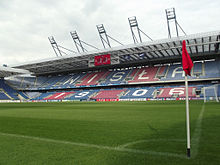 Wisła Kraków Stadium
Wisła Kraków Stadium
Football is one of the most popular sports in the city,[106] and the teams with the largest following are thirteen-time Polish champions Wisła Kraków,[107] and five-time champions Cracovia.[108] Other football clubs include Hutnik Kraków, Wawel Kraków and one-time Polish champion Garbarnia Kraków. There is also the first-league rugby club Juvenia Kraków. Kraków has a number of additional, equally valued sports teams including eight-time Polish ice hockey champions Cracovia Kraków and the twenty-time women's basketball champions Wisła Kraków.
The Cracovia Marathon, with over a thousand participants from two dozen countries annually, has been held in the city since 2002.[109] Poland's first F1 racing driver Robert Kubica was born and brought up in Krakow, as was Top 10 ranked womans tennis player Agnieszka Radwańska.
The construction of the new Krakow Arena has started in May 2011. For concerts, indoor athletics, hockey, basketball, futsal. The Arena will be ready in 2013 cost will be 363 million zł Will serve the viewers up to 15 thousand. In the case of concert, when the scene is set on the lower arena, hall can accommodate up to 18 thousand people.
Transport
Main article: Transport in KrakówPublic transport is based on a fairly dense network of streetcar and bus lines operated by a municipal company, supplemented by a number of private minibus operators. Local trains connect some of the suburbs. The bulk of the city’s historic area has been turned into a pedestrian zone with rickshaws and horse buggies; however, the tramlines run within a three-block radius.[110]
Rail connections are available to most Polish cities. Trains to Warsaw depart every hour. International destinations include Berlin, Budapest, Prague, Hamburg, Lvov, Kiev, and Odessa (June–September).[111] The main railway station is located just outside the Old Town District and is well-served by public transport.
The Kraków airport, (John Paul II International Airport Kraków-Balice, Polish: Międzynarodowy Port Lotniczy im. Jana Pawła II Kraków-Balice,(IATA: KRK)) is 11 km (7 mi) west of the city. Direct trains cover the route between Kraków Główny train station and the airport in 15 minutes. The annual capacity of the airport is estimated at 1.3 million passengers (second largest airport in Poland); however, in 2007 more than 3.042 million people used the airport, giving Kraków Airport 15 percent of all air passenger traffic in Poland. The passenger terminal is undergoing extension and is being adapted to meet the requirements of the Schengen Treaty.[112] Currently, the airport offers 59 connections and is operated by 2 terminals (international T1 and national T2). The Katowice International Airport is located about 75 minutes from Krakow.[113]
Education
Main article: Education in KrakówKraków is a major centre of education. More than ten university or academy-level institutions offer courses in the city, with 170,000 students.[80] Jagiellonian University, the oldest and best known university in Poland and ranked by the Times Higher Education Supplement as the best university in the country,[114][115] was founded in 1364 as the Cracow University and renamed in 1817 to commemorate the Jagiellonian dynasty of Polish-Lithuanian kings.[116] Its principal academic asset is the Jagiellonian Library, with more than 4 million volumes, including a large collection of medieval manuscripts[117] like Copernicus' De Revolutionibus and the Balthasar Behem Codex. With 42,325 students (2005) and 3,605 academic staff, the Jagiellonian University is also one of the leading research centres in Poland. Famous historical figures connected with the University include Saint John Cantius, Jan Długosz, Nicolaus Copernicus, Andrzej Frycz Modrzewski, Jan Kochanowski, King John III Sobieski, Pope John Paul II and Nobel laureates Ivo Andrić and Wisława Szymborska.[118]
AGH University of Science and Technology, established in 1919, is the second-largest technical university in Poland, with more than 15 faculties and student enrollment exceeding 30,000.[119] It was ranked by the Polish edition of Newsweek as the best technical university in the country for the year 2004.[120] During its 80-year history, more than 73,000 students graduated from AGH with master's or bachelor's degrees. Some 3,600 persons were granted the degree of Doctor of Science, and about 900 obtained the qualification of Habilitated Doctor.[121]
Other institutions of higher learning include Academy of Music in Kraków first conceived as conservatory in 1888, one of the oldest and most prestigious conservatories in Central Europe and a major concert venue;[122] Cracow University of Economics, established in 1925;[123] Pedagogical University, in operation since 1946;[124] Agricultural University of Cracow, offering courses since 1890 (initially as a part of Jagiellonian University);[125] Academy of Fine Arts, the oldest Fine Arts Academy in Poland, founded by the Polish painter Jan Matejko; Ludwik Solski Academy for the Dramatic Arts;[126] The Pontifical Academy of Theology;[127] and Cracow University of Technology, which has more than 37,000 graduates.
Knowledge and Innovation Community EIT
Krakow is one of the co-location centres of Knowledge and Innovation Community (Sustainable Energy) of The European Institute of Innovation and Technology (EIT).[128] The complete list of co-location centers - KIC Inno Energy include: CC Germany in Karlsruhe, CC Alps Valleys in Grenoble, CC Benelux in Eindhoven/Leuven, CC Iberia in Barcelona, CC PolandPlus in Krakow, and CC Sweden in Stockholm.
InnoEnergy is an integrated alliance of reputable organizations from the education, research and industry sectors. It was created based on long standing links of cooperation as well as the principles of excellence. The partners have jointly developed a strategy to tackle the weaknesses of the European innovation landscape in the field of sustainable energy.[129]
Religious sites
Main articles: Churches of Kraków and Synagogues of KrakówThe metropolitan city of Kraków is known as the city of churches. The abundance of landmark, historic temples along with the plenitude of monasteries and convents earned the city a countrywide reputation as the "Northern Rome" in the past. The churches of Kraków comprise over 120 places of worship of which over sixty were built in the 20th century.[130] Denominations include Roman Catholicism (48 Churches), Jehovah's Witnesses (10 Kingdom Hall), Protestantism (8 Churches), Buddhism (5), Polish Orthodox Church (1 Church), Polish Catholic Church (1 Church) and Mariavite Church.
Kraków contains also an outstanding collection of monuments of Jewish sacred architecture unmatched anywhere in Poland. Kraków was an influential center of Jewish spiritual life before the outbreak of World War II, with all its manifestations of religious observance from Orthodox to Chasidic and Reform flourishing side by side. There were at least ninety synagogues in Kraków active before the Nazi German invasion of Poland, serving its burgeoning Jewish community of 60,000–80,000 (out of the city's total population of 237,000), established since the early 12th century.[131]
Most synagogues of Kraków were ruined during World War II by the Nazis who despoiled them of all ceremonial objects, and used them as storehouses for ammunition, firefighting equipment, as general storage facilities and stables. The post-Holocaust Jewish population of the city had dwindled to about 5,900 before the end of 1940s, and by 1978, the number was further reduced in size to a mere 600 by some estimates. In recent time, thanks to the efforts of the local Jewish and Polish organizations including foreign financial aid from the American Jewish Joint Distribution Committee, many synagogues underwent major restorations, while others continue to serve as apartments.[131]
International relations
Contemporary foreign names for the city
Kraków is referred to by various names in different languages. The city is known in Czech and Slovak as Krakov, in Hungarian as Krakkó, in Lithuanian as Krokuva, in German as Krakau, in Latin, Spanish and Italian as Cracovia, in French as Cracovie, in Portuguese as Cracóvia and in Russian as Краков. Ukrainian and Yiddish languages refer to it as Krakiv (Краків) and Kroke (קראָקע) respectively.[132] Names of Kraków in different languages are also available.
Twin towns — Sister cities
Kraków is twinned, or maintains close relations, with more than 30 cities around the world:[133]
 Bordeaux, France (since 1993)[133]
Bordeaux, France (since 1993)[133]
 Bratislava, Slovakia [133][134]
Bratislava, Slovakia [133][134]
 Budapest, Hungary (since 2005)[133]
Budapest, Hungary (since 2005)[133]
 Cambridge, Mass., USA (since 1989)[135]
Cambridge, Mass., USA (since 1989)[135]
 Curitiba, Brazil (since 1993)[133]
Curitiba, Brazil (since 1993)[133]
 Cusco, Peru [133][136]
Cusco, Peru [133][136]
 Edinburgh, United Kingdom (since 1995) [137]
Edinburgh, United Kingdom (since 1995) [137]
 Fes, Morocco (since 2004)[133]
Fes, Morocco (since 2004)[133]
 Florence, Italy (since 1992)[133]
Florence, Italy (since 1992)[133]
 Frankfurt, Germany (since 1991)[133][138]
Frankfurt, Germany (since 1991)[133][138]
 Göteborg, Sweden (since 1990)[133]
Göteborg, Sweden (since 1990)[133] Grozny, Russia (since 1997) [139]
Grozny, Russia (since 1997) [139]
 Innsbruck in Austria (since 1998)[133]
Innsbruck in Austria (since 1998)[133]
 Kiev, Ukraine (since 1993)[133]
Kiev, Ukraine (since 1993)[133]
 Lahore, Pakistan
Lahore, Pakistan
 La Serena, Chile (since 1995)[133]
La Serena, Chile (since 1995)[133]
 Leipzig, Germany (since 1995)[133][140]
Leipzig, Germany (since 1995)[133][140]
 Leuven, Belgium (since 1991)[133]
Leuven, Belgium (since 1991)[133]
 Lviv, Ukraine (since 1995)[133]
Lviv, Ukraine (since 1995)[133]
 Milan, Italy (since 2003)[133][141]
Milan, Italy (since 2003)[133][141]
 Nuremberg, Germany (since 1991)[133]
Nuremberg, Germany (since 1991)[133]
 Orléans, France (since 1992)[133]
Orléans, France (since 1992)[133] Pécs, Hungary (since 1998)[133]
Pécs, Hungary (since 1998)[133]
 Rochester, NY, USA (since 1973)[133]
Rochester, NY, USA (since 1973)[133]
 Quito, Ecuador [133]
Quito, Ecuador [133]
 St Petersburg, Russia (since 2006)[133]
St Petersburg, Russia (since 2006)[133]
 San Francisco, CA, USA (since 2009)[133]
San Francisco, CA, USA (since 2009)[133]
 Seville, Spain (since 2002)[133]
Seville, Spain (since 2002)[133]
 Solothurn, Switzerland (since 1990)[133]
Solothurn, Switzerland (since 1990)[133]
 Tbilisi, Georgia[133]
Tbilisi, Georgia[133]
 Veliko Turnovo, Bulgaria (since 1975)[133]
Veliko Turnovo, Bulgaria (since 1975)[133]
 Vilnius, Lithuania[133]
Vilnius, Lithuania[133]
 Zagreb, Croatia (since 1975)[133][142][143]
Zagreb, Croatia (since 1975)[133][142][143]See also
- Lesser Polish Way
- Tourism in Poland
References
Bibliography
- Simpson, Scott; Zukowska, Helena (15 April 2008). Travellers Kraków, 3rd: Guides to Destinations Worldwide (Fourth ed.). Peterborough, United Kingdom: Thomas Cook Publishing. ISBN 9781841579016. http://books.google.com/?id=dXlPGgAACAAJ. Retrieved 11 March 2010.
Notes
- ^ "Microsoft Word - Aglomeracja I.doc" (in (Polish)) (PDF). http://www.stat.gov.pl/cps/rde/xbcr/krak/ASSETS_07m22_01.pdf. Retrieved 2011-06-02.
- ^ a b c d e The Municipality Of Kraków Press Office, 1996–2007, in participation with ACK Cyfronet of the AGH University of Science and Technology, "Our City. History of Krakow, archaeological findings". http://www.krakow.pl/en/miasto/?id=dzieje.html. Retrieved 2007-09-11.
- ^ Kraków, at Cracow.welcome.com
- ^ The judge: William P. Clark, Ronald ... - Google Books. books.google.co.uk. 2007-10. ISBN 9781586171834. http://books.google.com/?id=3FV3puE5hdQC&pg=PA171&dq=first+non-Italian+pope+in+455+years. Retrieved 2009-07-19.
- ^ Properties inscribed on the World Heritage list, Poland. UNESCO World Heritage Centre. Last updated: 3 September 2010
- ^ 2nd session of the Committee UNESCO World Heritage Committee. Washington, D.C. 5–8 September 1978.
- ^ (Polish) Maria Curie-Skłodowska University, Lublin. Historical forum, "Krak or Krakus?". http://www.historycy.org/index.php?showtopic=20414. Retrieved 2007-06-10.
- ^ a b (Polish) October 9, 2002 Ordinance of the Kraków City Council no. CXXIII/1150/02 on the symbols of the Royal Capital City of Kraków (PDF) and February 6, 2004 Ordinance of the Mayor of Kraków no. 167/2004 on the use of the symbols of the Royal Capital City of Kraków (PDF)
- ^ "Wawel Kraków". http://www.cracow-life.com/poland/wawel-krakow-castle. Retrieved 2007-09-12. Wawel Hill past and present
- ^ Wawel Royal Castle, homepage. Maria Dębicka, "The Dragon’s Den". http://www.cyfronet.pl/waweln/en/index.php?op=11,1,5. Retrieved 2007-09-11.[dead link]
- ^ Charles Cawley, Poland. Mieszko I, 966-992. Foundation for Medieval Genealogy, 2006. Cite #51: Dzięcioł, Witold (1963) The Origins of Poland (Veritas, London), p. 148. Accessed 17 March 2011.
- ^ Francis W. Carter (1994). Trade and urban development in Poland: an economic geography of Cracow. Cambridge University Press. p. 71. ISBN 0521412390. http://books.google.com/?id=-XdByzq85zMC&pg=PA71&dq=%22Ethnic+structure+of+Cracow,+Kazimierz+and+Kleparz%22#v=onepage&q=%22Ethnic%20structure%20of%20Cracow%2C%20Kazimierz%20and%20Kleparz%22&f=false. Retrieved May 19, 2011.
- ^ Krystyna and Frank Van Dongen. "The royal castle in Kraków". http://www.pl-info.net/poland/major-cities/cracow/castle.html. Retrieved May 19, 2011.
- ^ Stanisław Rosik and Przemysław Urbańczyk. "Poland - Ecclesiastical organization". http://christianization.hist.cam.ac.uk/regions/poland/poland-eccl-org.html. Retrieved May 19, 2011.
- ^ a b Marek Strzala, "The green belt of Kraków Planty". http://www.krakow-info.com/planty.htm. Retrieved 2007-09-15.
- ^ Edmund Kolodziejczyk. "Poland. Geography, political history and the position of the church". Catholic Encyclopedia. http://72.14.253.104/search?q=cache:YwNjZ_neCKQJ:www.catholicity.com/encyclopedia/p/poland.html+Tatar+invasions+in+1241,+1259+and+1287&hl=en&ct=clnk&cd=62. Retrieved May 19, 2011. "For the Overview of historic events see: Tartar raids"
- ^ Sharon & Peter Pfeiffer, "Krakow. A brief history." "The establishment of a university". http://www.magma.ca/~pfeiffer/poland/kra_history.htm. Retrieved 2007-05-12.
- ^ Hanseatic towns: Kraków, Polonia Online, Retrieved on 25 September 2007.
- ^ Davies, Norman (2005). God's Playground: A History of Poland. Oxford University Press. ISBN 0199253390. http://books.google.com/?id=b912JnKpYTkC&pg=PA118&dq=%22Norman+Davies%22+%22God%27s+Playground%22+%22Golden+Age%22. Retrieved 2008-01-21.p.118. See vol.1, chapter 5.
- ^ Michael J. Mikoś, Polish Renaissance Literature: An Anthology. Ed. Michael J. Mikoś. Columbus, Ohio/Bloomington, Indiana: Slavica Publishers. 1995. ISBN 978-0-89357-257-0 First chapters online, Retrieved on 25 September 2007
- ^ Cracow's Historic center, UNESCO report, retrieved on 4 October 2007
- ^ Old Synagogue in Krakow, Retrieved on 25 September 2007.
- ^ Harold B. Segel, Renaissance Culture in Poland: The Rise of Humanism, 1470–1543, Cornell University Press, 1989, ISBN 0801422868, Google Print, p.252
- ^ Norman Davies, God's Playground, vol.1, chapter 5. Books.google.com. 2005. ISBN 9780199253395. http://books.google.com/?id=b912JnKpYTkC&pg=PA118&dq=%22Golden+Age%22+author:%22norman+davies%22. Retrieved 2010-11-09.
- ^ Wieslaw Wydra, "Die ersten in polnischer Sprache gedruckten Texte, 1475–1520", Gutenberg-Jahrbuch, Vol. 62 (1987), pp.88–94 (88)
- ^ "The Warsaw Voice", April 11, 1999. "Bell Woman of Wawel Hill". http://www.warsawvoice.pl/archiwum.phtml/9344/. Retrieved 2007-09-11.
- ^ T. Sturge Moore, "Albert Durer"; and Janusz Wałek, "Painting in Poland - A brief summary". http://www.pilsudski.org/English/Gallery/Painting.htm. Retrieved 2007-09-11.
- ^ Emil Kren and Daniel Marx, "Artists' biographies."Hans Süss von Kulmbach; J. Paul Getty Museum, "Artists: Hans von Kulmbach"; also, Agnieszka Janczyk, Kazimierz Kuczman, Joanna Winiewicz-Wolska, "Wawel Royal Castle, The National Art Collection (homepage)". http://www.wawel.krakow.pl/en/index.php?op=19,33. Retrieved 2007-09-11.
- ^ Jagiellonian University Centre for European Studies, "A Very Short History of Kraków", see: "1596 administrative capital, the tiny village of Warsaw". http://www.ces.uj.edu.pl/european/krakow/krakow_history.htm. Retrieved 2007-05-12.
- ^ Dorota Wasik, Cracow University of Economics, International Programs Office: "A short long history of Cracow", see: "The Polish struggle for freedom". http://www.louisiana.edu/Academic/Sciences/CMPS/Conferences/iticse99/Cracow/History.html. Retrieved 2007-05-12.
- ^ (Polish) Grzegorz Reszka, based on: T. Cegielski, K. Zielińska: "Historia. Dzieje nowożytne", J. A. Gierowski: "Historia Polski 1764–1864", Lubicz-Pachoński: "Kościuszko na ziemi krakowskiej", A. Radziwiłł, W. Roszkowski: :Historia 1789–1871:, W. Malski: "Amerykańska wojna pułkownika Kościuszki". "Insurekcja kościuszkowska 1764–1798". http://www.polskiedzieje.pl/artykul,idart-139,t-Insurekcja-kosciuszkowska. Retrieved 2007-07-26.
- ^ a b Cresswell, Peterjon (2009-05-12). Frommer's Kraków Day by Day - Google Books. books.google.co.uk. ISBN 9780470697108. http://books.google.com/?id=WobHDtqmCzIC&pg=PA171&dq=Duchy+of+Warsaw+1809+Krak%C3%B3w&q=. Retrieved 2009-08-14.
- ^ "Republic of Cracow (historical state, Poland) – Britannica Online Encyclopedia". britannica.com. http://www.britannica.com/EBchecked/topic/141562/Republic-of-Cracow. Retrieved 2009-08-14.
- ^ Chambers's encyclopaedia: a ... - Google Books. books.google.co.uk. 1862. http://books.google.com/?id=pgsbAAAAYAAJ&pg=PA679&dq=%22Grand+Duchy+of+Cracow%22+1846&q=%22Grand%20Duchy%20of%20Cracow%22%201846. Retrieved 2009-08-14.
- ^ Marek Strzala, "History of Krakow" "(see: Franz Joseph I granted Kraków the municipal government)". http://www.krakow-info.com/history.htm. Retrieved 2007-05-12.
- ^ (Polish) Bożena Szara, Przeglad Polski (6 April 2001): "Miedzy dwoma swiatami czyli powrot do przeszlosci.". http://www.dziennik.com/www/dziennik/kult/archiwum/01-06-01/pp-04-06-04.html. Retrieved 2007-05-18.
- ^ ''Cracow: City of Treasures'', by Beata Moore. Books.google.com. 2006-08-25. ISBN 9780711225718. http://books.google.com/?id=5h2zXFFr2j4C&pg=PT83&dq=%22painter+Jan+Matejko%22+cracow. Retrieved 2010-11-09.
- ^ "Jan Matejko: The Painter and Patriot". http://info-poland.buffalo.edu/classroom/JM/JM.html. Retrieved 2007-05-18.
- ^ Maria Prussak, Adam Mickiewicz Institute, April 2006. Profiles. Visual arts, literature, theatre: "Stanisław Wyspiański.". http://www.culture.pl/en/culture/artykuly/os_wyspianski_stanislaw. Retrieved 2007-09-02.
- ^ (Polish) Adam Mickiewicz Institute: Culture.pl, editor in chief: Andrzej Lubomirski, Warsaw, ISSN 1734–0624, "Fin-de-Siecle in Kraków". http://www.culture.pl/pl/culture/artykuly/wy_wy_fin_de_siecle_krakow. Retrieved 2007-05-18.
- ^ (Polish) Artur Turyna, "Kraków - najważniejsze daty - Okres IV - od początku XX wieku do dziś". http://www.wawel.net/kalendarz4.htm. Retrieved 2007-09-12.
- ^ Wood, Nathaniel D. (2010). Becoming Metropolitan: Urban Selfhood and the Making of Modern Cracow. DeKalb: Northern Illinois University Press. pp. 272. ISBN 978-0-87580-422-4. http://www.amazon.com/exec/obidos/ASIN/0875804225.
- ^ (Polish) Bohdan Urbankowski, Bohdan Urbankowski (1997). Józef Piłsudski: marzyciel i strateg (Józef Piłsudski: Dreamer and Strategist). Wydawnictwo ALFA, Warsaw, 1997. pp. 171–172. ISBN 8370019145.
- ^ (Polish) Paweł Stachnik, Dziennik Polski, 21 September 2004. "Okrzyk na cześć cesarza.". http://www.twierdza.art.pl/a_okrzyk.htm. Retrieved 2007-09-01.
- ^ Frucht, Richard C. (2005). Eastern Europe: an introduction to ... - Google Books. books.google.co.uk. ISBN 9781576078006. http://books.google.com/?id=lVBB1a0rC70C&pg=PA23&dq=Polish+Liquidation+Committee+October+1918&q=Polish%20Liquidation%20Committee%20October%201918. Retrieved 2009-08-14.
- ^ Encyclopedia of Rusyn history and ... - Google Books. books.google.co.uk. 2002. ISBN 9780802035660. http://books.google.com/?id=ovCVDLYN_JgC&pg=PA370&dq=Austrian+rule+in+Krak%C3%B3w+ended+in+1918&q=. Retrieved 2009-08-14.
- ^ Eilat Gordin Levitan, "Krakow old scenes, including historical photographs". http://www.eilatgordinlevitan.com/krakow/krkw_pages/krkw_old_scenes.html. Retrieved 2007-09-01.
- ^ Anna M. Cienciala, History 557 Lecture Notes, 2002 (Revised Fall. 2003), "16B. Eastern Europe in World War II: October 1939 – May 1945.". http://web.ku.edu/~eceurope/hist557/lect16.htm. Retrieved 2007-11-22.
- ^ (Polish) Edward Burek, (editor). “Sonderaktion Krakau” in Encyklopedia Krakowa. Krakow: PWM, 2000
- ^ Bieberstein: Zagłada Żydów w Krakowie. Kraków 1985. J. Kast, B. Siegler, P. Zinke: Das Tagebuch der Partisanin Justyna. Jüdischer Widerstand in Krakau. Berlin 1999. Articles from Kraków newspapers (mostly from the local "Gazeta Wyborcza") published in March 2003 on the 60th anniversary of the liquidation of the Kraków ghetto. Featuring historical maps. "The Kraków Ghetto 1940–1943". http://www.historyplace.com/worldwar2/holocaust/h-krak-beg.htm. Retrieved 2007-09-11.
- ^ All for Love - Google Books. books.google.co.uk. 2005. ISBN 9781740455961. http://books.google.com/?id=iSGb79f1TRcC&pg=PA231&dq=Roman+Pola%C5%84ski+krakow+ghetto. Retrieved 2009-07-20.
- ^ Crowe, David (2007-05-07). Oskar Schindler: The Untold Account ... - Google Books. books.google.co.uk. ISBN 9780465002535. http://books.google.com/?id=EYOu2o3h1OwC&pg=PA193&dq=Oskar+Schindler+krakow+ghetto. Retrieved 2009-07-20.
- ^ Jerzy Lukowski, Hubert Zawadzki, A Concise History of Poland, Cambridge University Press, 2006, ISBN 052185332X, Google Print, p.66
- ^ "Science & Higher Education in Cracow 2007". http://www.cracow-science.welcome.com.pl/Jagiellonian-University,WidokDzialArtykulyArtykul,78,195.html. Retrieved 2007-11-23.
- ^ Jagiellonian University center for European Studies, see: ""Worker's paradise" of concrete". http://www.ces.uj.edu.pl/european/krakow/krakow_history.htm. Retrieved 2007-05-12.
- ^ a b Encyclopædia Britannica, "Nowa Huta (section of Kraków, Poland)". http://www.britannica.com/eb/topic-421313/article-9056415. Retrieved 2007-11-23.
- ^ Jerzy Aleksander Karnasiewicz, Nowa Huta. Okruchy życia i meandry historii (English: Nowa Huta. Crumbs of Life and the Meanders of History), photo anthology; Wydawnictwo Towarzystwo Slowaków w Polsce, Kraków, 2003; ISBN 83-89186-67-5
- ^ Witold Stefan Alexandrowicz and Zofia Alexandrowicz, Acta Carsologica, Slovenian Academy Of Sciences "Pattern of karst landscape of the Cracow Upland (South Poland)". http://carsologica.zrc-sazu.si/?stran=article&id=185. Retrieved 2007-09-12.
- ^ Institute of Environmental Sciences of the Jagiellonian University, "The forms of nature protection within the city limits". http://www.eko.uj.edu.pl/przyrodakrakowa/formy_e.htm. Retrieved 2007-09-12.
- ^ (English) "Institute of Meteorology and Water Management". www.imgw.pl. http://www.imgw.pl/index.php?option=com_content&view=article&id=147&Itemid=180. Retrieved 2010-10-02.
- ^ Biuletyn Informacji Publicznej (Bulletin of Public Information), "Radni Miasta Krakowa V kadencji (Kraków City Councillors of the 5th term)". http://www.bip.krakow.pl/?mmi=9859. Retrieved 2007-09-15.
- ^ a b Biuletyn Informacji Publicznej (Bulletin of Public Information), "Dziennik Ustaw Nr 113 poz. 984". http://www.bip.krakow.pl/?id=96. Retrieved 2007-09-15.
- ^ "Municipality, Mayor,www.krakow.pl". www.krakow.pl. http://www.krakow.pl/en/samorzad/prezydent/?id=jacek_majchrowski.html. Retrieved 2009-07-20.
- ^ "Members of Polish Sejm elected from Kraków constituency - VisWiki". viswiki.com. http://viswiki.com/en/Members_of_Polish_Sejm_elected_from_Krak%C3%B3w_constituency. Retrieved 2009-07-20.
- ^ Laura Brunell, Brunell, Laura (2005). Institutional Capital: Building Post-communist Government Performance. University Press of America. ISBN 9780761829560. http://books.google.com/?id=R1Faumf7JMMC&pg=PA50&dq=history+of+Krakow+Cracow+after+1945. Retrieved 2007-09-05. University Press of America, Lanham, Maryland, 2005, ISBN 0761829563.
- ^ Biuletyn Informacji Publicznej (Bulletin of Public Information). Raport o stanie miasta, 2001. "BEZPIECZEŃSTWO PUBLICZNE". Archived from the original on July 15, 2007. http://web.archive.org/web/20070715204454/http://www.krakow.pl/gospodarka/html/raport-2001/bezpiecz.html. Retrieved 2007-09-05.
- ^ a b "Boroughs of Kraków". www.krakow-info.com. http://www.krakow-info.com/district.htm. Retrieved 2009-07-24.
- ^ Rick Steves, "Poland Rediscovered: ." Published in Rick Steves' Eastern Europe, 2005 edition. "Krakow, Auschwitz and Warsaw". http://www.ricksteves.com/tvr/polandrse310_details.htm. Retrieved 2007-09-12.
- ^ Original Kraków City Hall bylaw Nr XXI/143/91 (unpublished) introduced on 27 March 1991; current municipal borders established according to City bylaw Nr XVI/192/95 for 19 April 1995. Source: "Gazeta Urzędowa Miasta Krakowa Nr 10, poz. 84" (PDF). http://www.cyfronet.krakow.pl/mk/bip/rada/uchwaly/show_pdf.php?id=2112. Retrieved 2007-09-14.[dead link]
- ^ Global Portal of Diplomats at eDiplomat.com. Notes on Poland including recreation, entertainment, social and religious life, "Krakow". http://www.ediplomat.com/np/post_reports/pr_pl.htm. Retrieved 2007-09-15.
- ^ a b Jeffrey Zuehlke, Zuehlke, Jeffrey. Poland in Pictures. Twenty-First Century Books. p. 72. ISBN 9780822526766. http://www.google.ca/books?id=NEChV1p84J0C&pg=PA72&dq=Krakow+historic+architecture&sig=AEFn6e1uth8u8Pc22wn9LOyZsHw. Retrieved 2007-09-15.
- ^ Kurtz, Michael J. (2006). America and the return of Nazi contraband. Cambridge University Press. p. 25.
- ^ O.J's Music, Trumpet Page: including music notations and sound samples in MP3 and Midi version. "Hejnal Mariacki - The Kraków Bugle Call". http://abel.hive.no/trumpet/articles/hejnal/. Retrieved 2007-09-14.
- ^ The oldest mention of Kraków hejnał dates back to 1392 (see: Katarzyna Górska. "Legenda o Hejnale Mariackim". http://www.krakow.come2europe.eu/o_miescie/legendy/hejnal-mariacki/. Retrieved June 2, 2011.) "...though there is probably no direct link (wrote Chris Hann) between this bugle call and a historical event in 1241, this does not detract from its meaning for Polish people today" (see: Chris Hann. "Discovering Social Anthropology in Galicia". http://www.era.anthropology.ac.uk/Teach-yourself/chap3.html. Retrieved 2007-12-19.).
- ^ a b "Microsoft Word - 13_DZIA. 05.doc" (in (Polish)) (PDF). http://www.stat.gov.pl/cps/rde/xbcr/krak/ASSETS_05m05_01.pdf. Retrieved 2010-11-09.
- ^ Central Statistical Office, Warsaw 2009, "Population. Size and Structure by Territorial Division, as of June 30, 2009" (PDF). http://www.stat.gov.pl/cps/rde/xbcr/gus/PUBL_L_ludnosc_stan_struktura_30_06_2009.pdf. Retrieved 2009-12-31.
- ^ See “Ludność” English: Population in Encyklopedia Krakowa. Kraków: PWN, 2000 (Polish)
- ^ (Polish) "Województwo małopolskie – Urząd Statystyczny w Krakowie". http://www.stat.gov.pl/urzedy/krak/. Retrieved 2007-09-08.
- ^ (Polish) "Raport z realizacji priorytetowego zadania Ministra Edukacji i Nauki, Kraków – marzec 2006". http://www.interklasa.pl/portal/dokumenty/r_mowa/strony_pol02/raport/raport.doc. Retrieved 2007-09-08.
- ^ a b c d e Kraków Real Estate Market, 2005. (Polish) / (English)
- ^ a b c d Economics, Magiczny Kraków
- ^ "Capgemini offices in Poland". http://www.capgemini.com/locations/europe/poland/. Retrieved 2007-09-11.
- ^ "About Sabre Holdings". sabre-holdings.com. http://www.sabre-holdings.com/aboutUs/locations/poland.html. Retrieved 2007-05-12.
- ^ [1][dead link]
- ^ "Krakow IT Companies / FrontPage". Krakowit.pbworks.com. 2010-01-11. http://krakowit.pbworks.com/FrontPage. Retrieved 2010-01-25.
- ^ (Polish) Level of unemployment in Poland by region, 31 May 2007. "Current statistics". http://www.bezrobocie.net/stat_powiaty.php. Retrieved 2007-09-14.
- ^ UNCATD’s World Investment Report 2011. Polish Information and Foreign Investment Agency, 26 July 2011.
- ^ (Polish) Biuro Informacji Publicznej (Office of Public Information). "Budżet Miasta Krakowa na rok 2011". http://www.bip.krakow.pl/zalaczniki/dokumenty/n/75694/karta.
- ^ (Polish) Biuro Informacji Publicznej, Kraków (Office of Public Information, Kraków). "Biuletyn Statystyczny Miasta Krakowa". http://www.bip.krakow.pl/?id=234. Retrieved 2007-09-15.
- ^ "A coffee break in Poland's culture capital - Europe, Travel - The Independent". London: www.independent.co.uk. 2000-10-22. http://www.independent.co.uk/travel/europe/a-coffee-break-in-polands-culture-capital-621787.html. Retrieved 2009-07-19.
- ^ Green, Peter S. (2000-06-16). "CITY GUIDE: Krakow: Poland's Fun City - The New York Times". www.nytimes.com. http://www.nytimes.com/2000/06/16/style/16iht-trkrak.t.html. Retrieved 2009-07-19.[dead link]
- ^ "Great deals and holiday guides to Eastern Europe - Poland - Krakow". www.uknetguide.co.uk. http://www.uknetguide.co.uk/Holiday-Guides/Eastern-Europe/Poland/Krakow.html. Retrieved 2009-07-19.
- ^ "European Capital of Culture in Poland again". opinia.co.uk. http://opinia.co.uk/index.php?option=com_content&view=article&id=323:european-capital-of-culture-in-poland-again&catid=50:newsculture&Itemid=193. Retrieved 2009-07-19.
- ^ "Basic info for foreigners in Krakow". www.krakow-info.com. http://www.krakow-info.com/basics.htm. Retrieved 2009-07-19.
- ^ "Krakow Landmarks | Historical monuments in Krakow". www.krakow-info.com. http://www.krakow-info.com/sights.htm. Retrieved 2009-07-19.
- ^ "Stary Teatr w Krakowie, homepage in Polish". http://www.stary-teatr.krakow.pl/. Retrieved 2007-05-12.
- ^ "Krakow Philharmonic". Filharmonia Krakowska. 2010. http://www.filharmonia.krakow.pl/index_en_no.html. Retrieved 2009-10-30.
- ^ Municipality Of Kraków Press Office, "Calendar of Annual Events, 2007". http://www.krakow.pl/en/kalendarium/?MODE=kalim&TYPE=find. Retrieved 2007-09-15.
- ^ "Krakowski Festiwal Filmowy". www.krakowfilmfestival.pl. http://www.krakowfilmfestival.pl/o_festiwalu. Retrieved 2009-07-20.[dead link]
- ^ "Cracow's Historic center - UNESCO World Heritage center". whc.unesco.org. http://whc.unesco.org/en/list/29. Retrieved 2009-07-20.
- ^ Ingrid Gustafson, Let's Go: Eastern Europe Published by Macmillan, page 444. Let's Go Publications, 2008.
- ^ "Krakow Day Trips". http://www.cracow-life.com/poland/krakow-day-trips. Retrieved 2007-10-12.
- ^ Starwood, "Explore Krakow". "Top 10 things to do in Kraków". http://poland.destinations.starwoodhotels.com/krakow_must_do.htm. Retrieved 2007-09-15.
- ^ "History, philosophy and photographs". http://www.grodzka.net.pl/travel/jordan_park.php. Retrieved 2007-09-15.
- ^ (Polish) Ryszard Burek (editor), Encyklopedia Krakowa, 2000, ISBN 83-01-13325-2.
- ^ "Krakow Sport Information Guide". Cracow Life. http://www.cracow-life.com/poland/krakow-sport. Retrieved 2009-07-19.
- ^ (Polish) Wisła portal, 1998–2007, "General info, history and successes". http://www.wislaportal.pl/info.php?id=21. Retrieved 2007-09-15.
- ^ (Polish) List of oldest Polish sports clubs featured in a newspaper retrospective. Zbigniew Chmielewski (2003). "Obok Czarnych znak Pogoni". Polityka 2414 (33). http://www.lwow.home.pl/sport/sport.html. Retrieved 2009-07-22.
- ^ Official website of the Cracovia Marathon Office, with list of winners, events, and registration form. "History of "Cracovia Marathon"". Urząd Miasta Krakowa. http://www.cracoviamaraton.pl/subp.php?idp=p2&id=7&tpl=txt&PHPSESSID=ecb5d9a3a395febb5cee498df1068254. Retrieved 2007-09-12.[dead link]
- ^ Marek Strzala, "Krakow. Varied Means of Transportation". http://www.krakow-info.com/transpor.htm. Retrieved 2007-05-12.
- ^ (Polish) Magiczny Kraków, city's official website. "International railway connections from Kraków". Archived from the original on June 26, 2006. http://web.archive.org/web/20060626153508/http://www.krakow.pl/turystyka/?id=praktyczne/12.html. Retrieved 2007-09-15.
- ^ World Airports Guide. "Kraków Airport". Archived from the original on 2007-12-19. http://web.archive.org/web/20071219112238/http://www.azworldairports.com/cfm/frame.cfm?src=http://www.azworldairports.com/airports/p2310krk.htm. Retrieved 2007-05-12.
- ^ "Lotnisko w Pyrzowicach" on www.e-krakow.com (Polish)
- ^ Times Higher Education Suplement (THES). "Jagiellonian University ranking among world universities" (PDF). Archived from the original on 2008-02-27. http://web.archive.org/web/20080227040124/http://www.ui.ac.id/indonesia/extra/tabelqs.pdf. Retrieved 2007-09-11. Rank 287 worldwide as the first Polish university listed among the top 500 in 2006.
- ^ QS Quacquarelli Symonds. Source: The Times Higher Education Suplement. QS World University Rankings. "Jagiellonian University ranking among world universities". Archived from the original on August 25, 2007. http://web.archive.org/web/20070825194905/http://www.topuniversities.com/worlduniversityrankings/results/2006/rankings_1520/?start=201&end=100. Retrieved 2007-09-11.
- ^ Jagiellonian University (homepage), "Calendar"
- ^ Jagiellonian University, "Treasures of the Jagiellonian Library". http://www.bj.uj.edu.pl/o_bib/skarby_BJ_en_.php. Retrieved 2007-09-11.[dead link]
- ^ The Nobel Foundation. "Wislawa Szymborska, Nobel Prize in Literature 1996". http://google.com/search?q=cache:Eq9YmP9KxiQJ:nobelprize.org/nobel_prizes/literature/laureates/1996/szymborska-bio.html+Szymborska+%22studied+Polish+Literature+and+Sociology+at+the+Jagiellonian+University%22&hl=en&ct=clnk&cd=2. Retrieved 2007-09-11.
- ^ AGH University of Science and Technology homepage, "AGH-UST staff and students, introduction". Archived from the original on 2006-10-03. http://web.archive.org/web/20061003161808/http://www.agh.edu.pl/english/Staff.php. Retrieved 2007-09-11.
- ^ Countrywide ranking of Polish universities, Newsweek (Polish edition), 22.03.2004, "Uczelnie w/g typu. Politechniki". Archived from the original on 2007-06-27. http://web.archive.org/web/20070627102511/http://www.agh.edu.pl/dokumenty/komunikaty/ranking/ranking.html. Retrieved 2007-09-11.
- ^ Professor Antoni S. Kleczkowski, AGH University of Science and Technology. "History of AGH-UST". Archived from the original on 2006-10-03. http://web.archive.org/web/20061003161914/http://www.agh.edu.pl/english/historia.php. Retrieved 2007-09-11.
- ^ "History of the Akademia Muzyczna". http://www.amuz.krakow.pl/en/?web=historia/. Retrieved 2010-08-23.
- ^ "Kraków University of Economics homepage". http://www.ae.krakow.pl/. Retrieved 2007-05-12.
- ^ "Akademia Pedagogiczna w Krakowie, homepage". http://www.wsp.krakow.pl/. Retrieved 2007-05-12.
- ^ "Akademia Rolnicza, homepage". http://www.ar.krakow.pl/index1.htm. Retrieved 2007-05-12.
- ^ "Państwowa Wyższa Szkoła Teatralna, homepage. Historical outline". Archived from the original on 2008-02-10. http://web.archive.org/web/20080210001616/http://www.pwst.krakow.pl/historia.jsp. Retrieved 2007-05-12.
- ^ "Papieska Akademia Teologiczna, homepage in English". http://www.pat.krakow.pl/eng/. Retrieved 2007-05-12.
- ^ "Knowledge and Innovation Community EIT, at". Eit.europa.eu. 2010-06-03. http://eit.europa.eu/home.html. Retrieved 2010-11-09.
- ^ KIC InnoEnergy. Designated Knowledge and Innovation Community, 16 December 2009. Retrieved 26 December 2009.
- ^ (Polish) Archidiecezja Krakowska, The churches of Krakow
- ^ a b Adam Dylewski, Where the Tailor Was a Poet... website created under the aegis of the Adam Mickiewicz Institute, Warsaw; chief editor: Dr. Piotr M. A. Cywinski. Editorial assistance: Dr. Anna Marta Szczepan-Wojnarska, and Kaja Wieczorek from Jewish Historical Institute, Warsaw
- ^ Andrzej Chwalba. Krakow w latach 1939–1945 (Cracow, 1939–1945). Dzieje Krakowa tom 5. Cracow: Wydawnictwo Literackie, 2002. (In Polish.)[2]
- ^ a b c d e f g h i j k l m n o p q r s t u v w x y z aa ab ac ad "Kraków otwarty na świat". www.krakow.pl. http://www.krakow.pl/otwarty_na_swiat/?LANG=UK&MENU=l&TYPE=ART&ART_ID=16. Retrieved 2009-07-19.
- ^ "Bratislava City - Twin Towns". © 2003-2008 Bratislava-City.sk. http://www.bratislava-city.sk/bratislava-twin-towns. Retrieved 2008-10-26.
- ^ "A Message from the Peace Commission: Information on Cambridge's Sister Cities," February 15, 2008. Retrieved 2008-10-12. Also in: Richard Thompson, "Looking to strengthen family ties with 'sister cities'," Boston Globe, October 12, 2008. Retrieved 2008-10-12.
- ^ "Ciudades Hermanas (Sister Cities)" (in Spanish). Municipalidad del Cusco. http://www.municusco.gob.pe/ver.php?id=6. Retrieved 2009-09-23.
- ^ "Edinburgh - Twin and Partner Cities". © 2008 The City of Edinburgh Council, City Chambers, High Street, Edinburgh, EH1 1YJ Scotland. Archived from the original on March 28, 2008. http://web.archive.org/web/20080328001653/http://www.edinburgh.gov.uk/internet/city_living/CEC_twin_and_partner_cities. Retrieved 2008-12-21.
- ^ "Frankfurt -Partner Cities". © 2008 Stadt Frankfurt am Main. http://www.frankfurt.de/sixcms/detail.php?id=502645. Retrieved 2008-12-05.
- ^ "Cайт Грозный Виртуальный при перепечатке материалов в онлайн проектах". Grozny Official Website. http://grozny-virtual.su. Retrieved 2008-11-01. (Russian)
- ^ "Leipzig - International Relations". © 2009 Leipzig City Council, Office for European and International Affairs. http://www.leipzig.de/int/en/int_messen/partnerstaedte/krakow/. Retrieved 2009-07-17.
- ^ "Milano - Città Gemellate". © 2008 Municipality of Milan (Comune di Milano). http://www.comune.milano.it/portale/wps/portal/CDM?WCM_GLOBAL_CONTEXT=/wps/wcm/connect/ContentLibrary/In%20Comune/In%20Comune/Citt%20Gemellate. Retrieved 2008-12-05.
- ^ "Foreign co-operation". http://www.krakow.pl/en/miasto/wizytowka/?id=wspolpraca.html. Retrieved 2007-11-01. from the municipality official website
- ^ "Intercity and International Cooperation of the City of Zagreb". © 2006-2009 City of Zagreb. http://www1.zagreb.hr/mms/en/index.html. Retrieved 2009-06-23.
Further reading
- Jane Hardy, Al Rainnie, Restructuring Krakow: Desperately Seeking Capitalism. Published 1996 by Mansell Publishing, 285 pages. Business, economics, finance. ISBN 0720122317.
- Edward Hartwig, Kraków, with Jerzy Broszkiewicz (contributor). Published 1980, by Sport i Turystyka, 239 pages. ISBN 8321723217.
- Bolesław T. Łaszewski, Kraków: karta z dziejów dwudziestolecia. Published 1985, by Bicentennial Pub. Corp. (original from the University of Michigan), 132 pages. ISBN 0912757086
- Joanna Markin, Bogumiła Gnypowa, Kraków: The Guide. Published 1996 by Pascal Publishing, 342 pages. ISBN 8387037281.
- Tim Pepper, Andrew Beattie, Krakow. Published 2007 by Hunter Pub Inc., 160 pages. ISBN 1843063085. The book includes description of public art galleries and museums.
- Scott Simpson, Krakow. Published 2003 by Thomas Cook, 192 pages. Transport, geography, sightseeing, history, and culture. Includes weblinks CD. ISBN 1841571873.
- Dorota Wąsik, Emma Roper-Evans, Krakow. Published 2002 by Somerset. Cultural guidebook series, 160 pages. ISBN 9630059304.
- Richard Watkins, Best of Kraków, Published 2006, by Lonely Planet, 64 pages, complemented by fold-out maps. ISBN 1741048222.
External links
- Kraków travel guide from Wikitravel
- Kraków Travel
- Oskar Schindler Factory Krakow
- Kraków Tourism information about Krakow
- Protect Kraków Heritage Campaign
- krakowmiasto.pl (Polish)
- Map: Kraków Heritage Under Threat
Categories:- World Heritage Sites in Poland
- Kraków
- City counties of Poland
- Cities and towns in Lesser Poland Voivodeship
- Former national capitals
- Historic Jewish communities
- European Capitals of Culture
Wikimedia Foundation. 2010.

